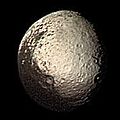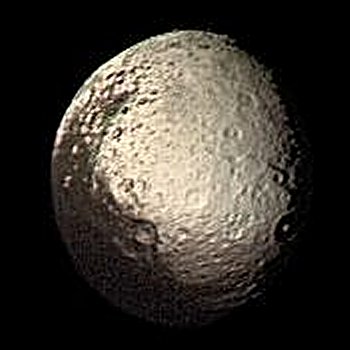Fichier:Iapetus by Voyager 2 - enhanced.jpg
Iapetus_by_Voyager_2_-_enhanced.jpg (350 × 350 Pixel, Fichiersgréisst: 19 KB, MIME-Typ: image/jpeg)
Versiounen
Klickt op e bestëmmten Zäitpunkt fir déi respektiv Versioun vum Fichier ze kucken.
| Versioun vum | Miniaturbild | Dimensiounen | Benotzer | Bemierkung | |
|---|---|---|---|---|---|
| aktuell | 17:29, 4. Abr. 2005 |  | 350 × 350 (19 KB) | Smartech~commonswiki | *'''Iapetus by Voyager 2 spacecraft, August 22, 1981''' *same as Iapetus_by_Voyager_2.jpg but focused on the mooon and feature-enhanced. *original image caption: Saturn's outermost large moon, Iapetus, has a bright, heavily cratered icy terrain and a da |
Benotze vu Fichieren
Dës Säit benotzt dëse Fichier:
Globaalt Benotze vum Fichier
Dës aner Wikie benotzen dëse Fichier:
- Benotzt op ar.wikipedia.org
- Benotzt op be-tarask.wikipedia.org
- Benotzt op be.wikipedia.org
- Benotzt op ca.wikipedia.org
- Benotzt op de.wikipedia.org
- Benotzt op el.wikipedia.org
- Benotzt op en.wikipedia.org
- Benotzt op eo.wikipedia.org
- Benotzt op es.wikipedia.org
- Benotzt op eu.wikipedia.org
- Benotzt op fr.wikipedia.org
- Benotzt op gl.wikipedia.org
- Benotzt op hr.wikipedia.org
- Benotzt op it.wikipedia.org
- Benotzt op ja.wikipedia.org
- Benotzt op ko.wikipedia.org
- Benotzt op la.wikipedia.org
- Benotzt op lt.wikipedia.org
- Benotzt op lv.wikipedia.org
- Benotzt op ms.wikipedia.org
- Benotzt op mwl.wikipedia.org
- Benotzt op no.wikipedia.org
- Benotzt op pl.wikipedia.org
Kuckt globale Gebrauch vun dësem Fichier.



